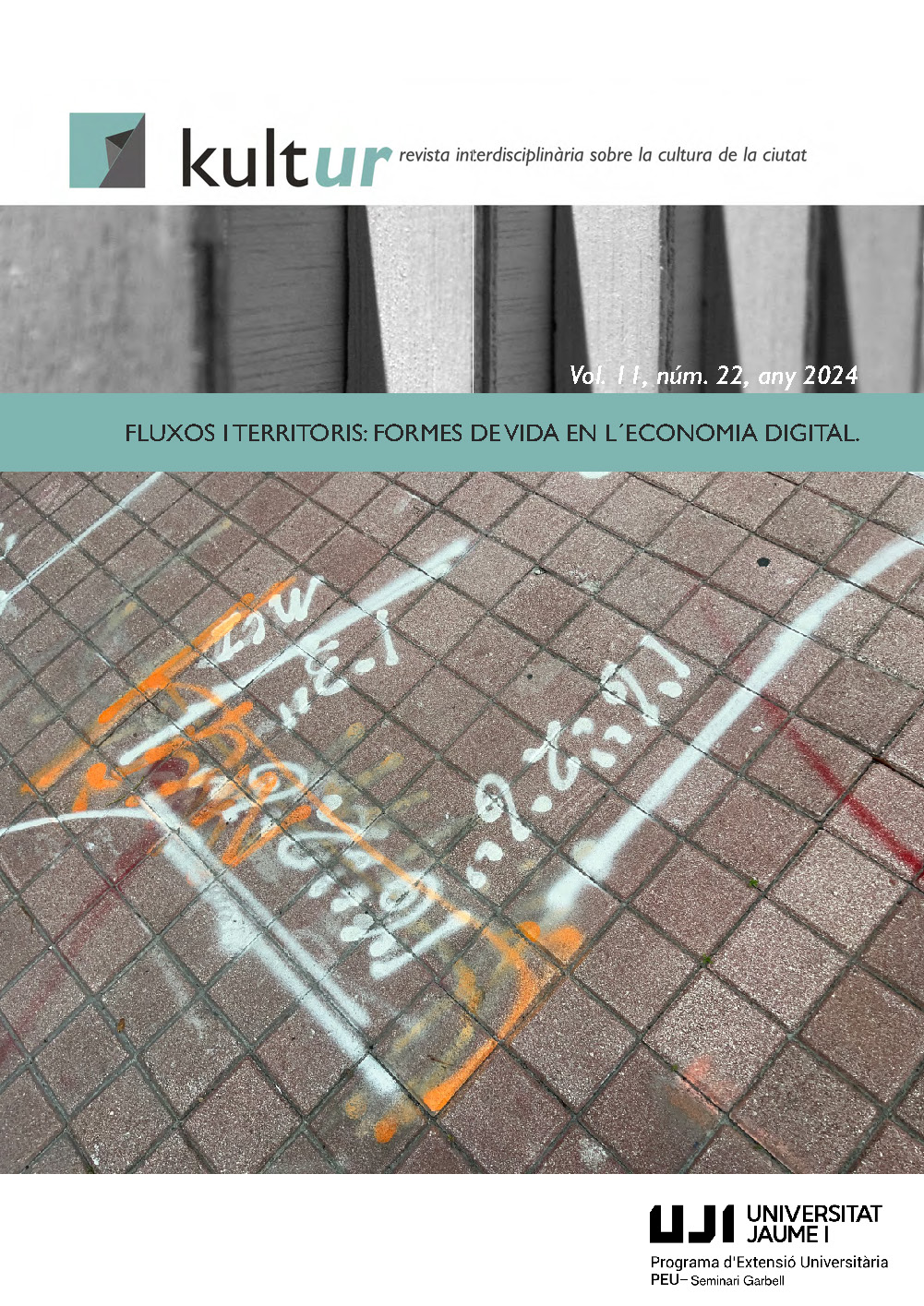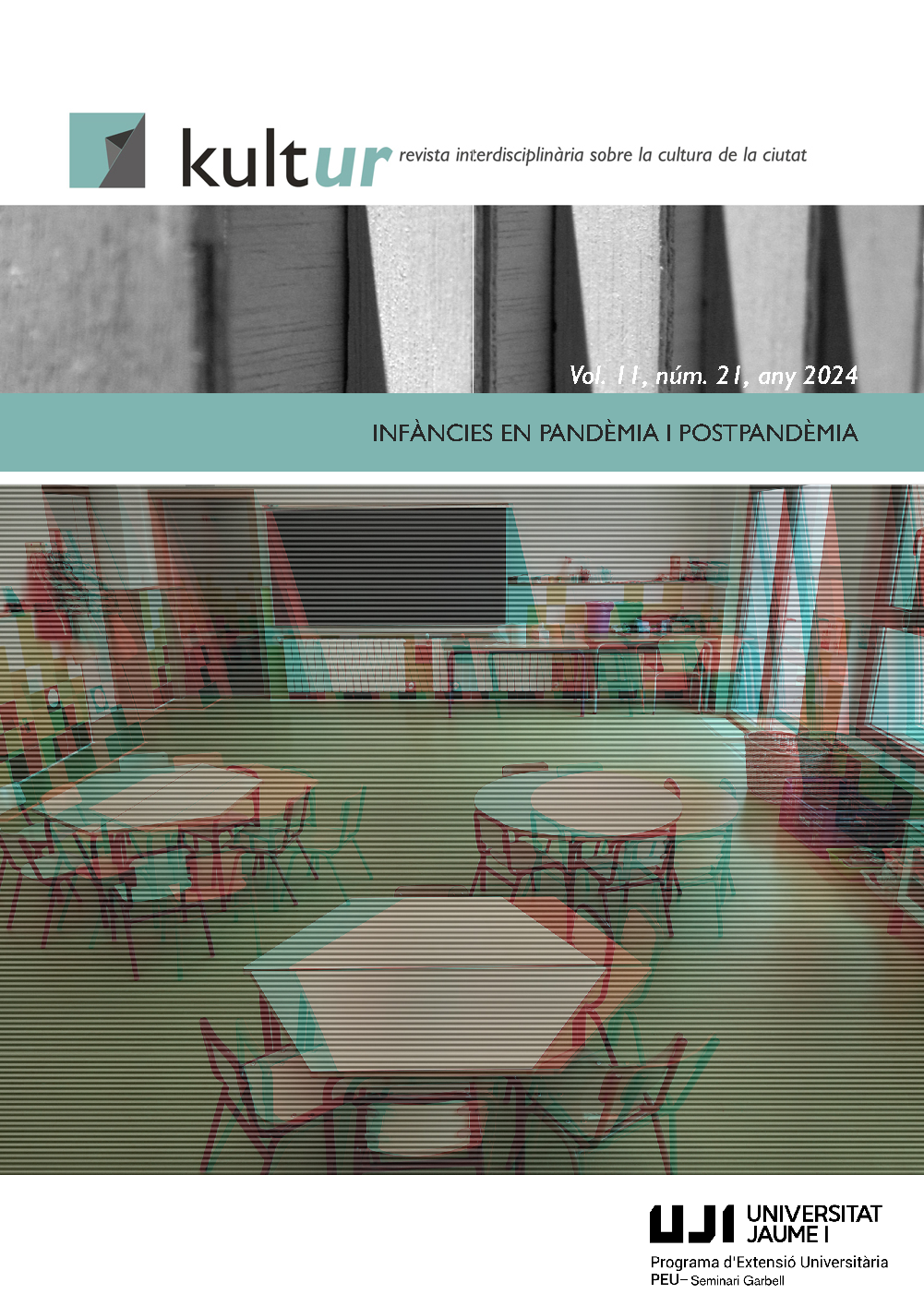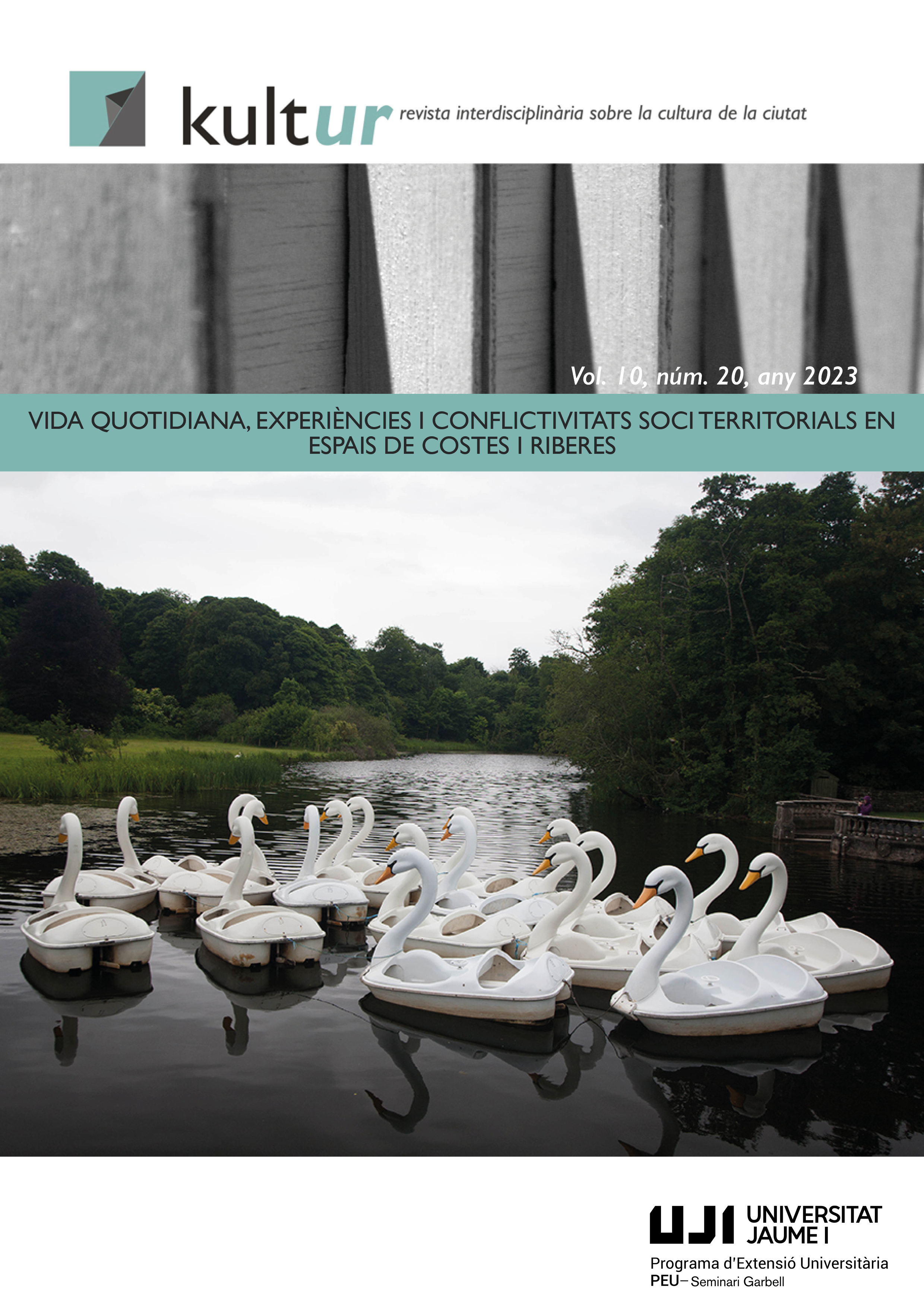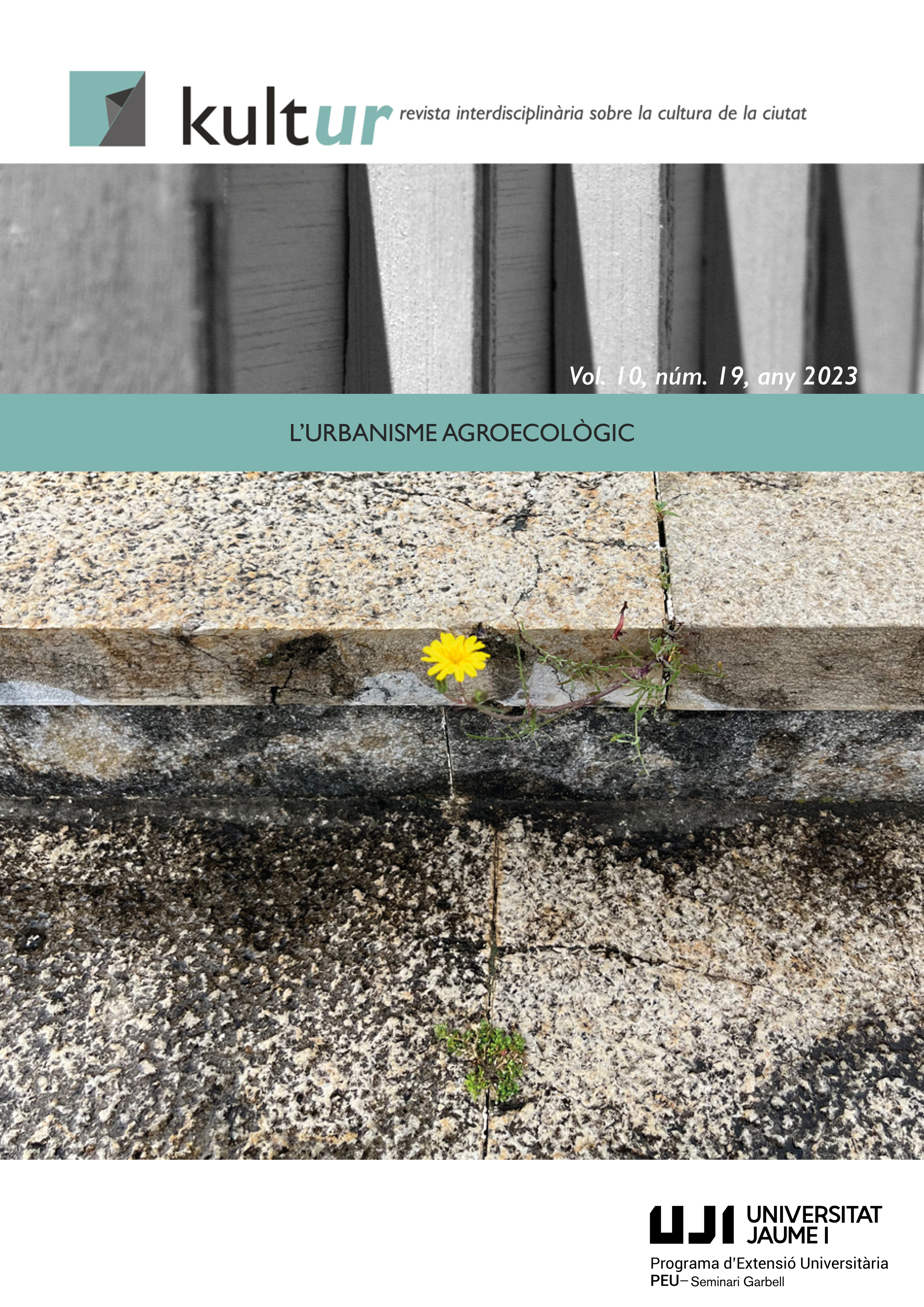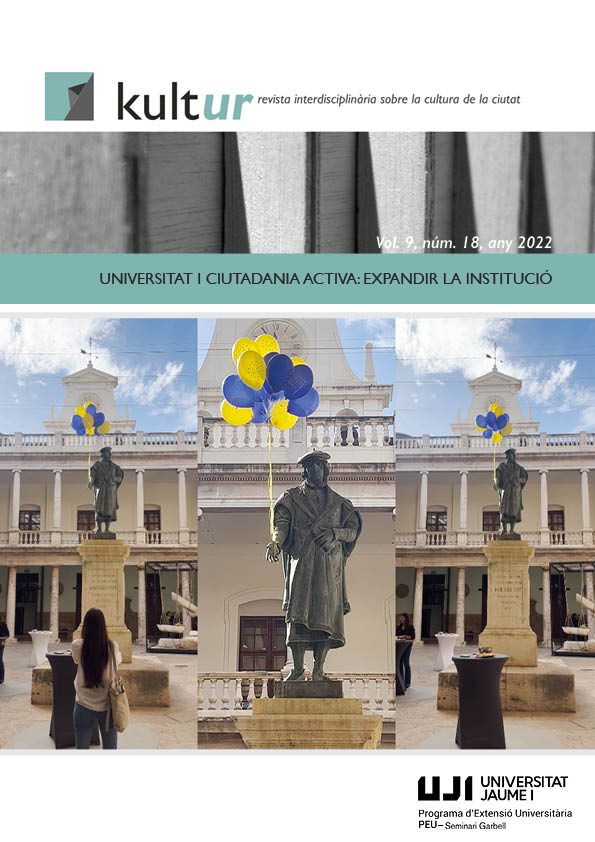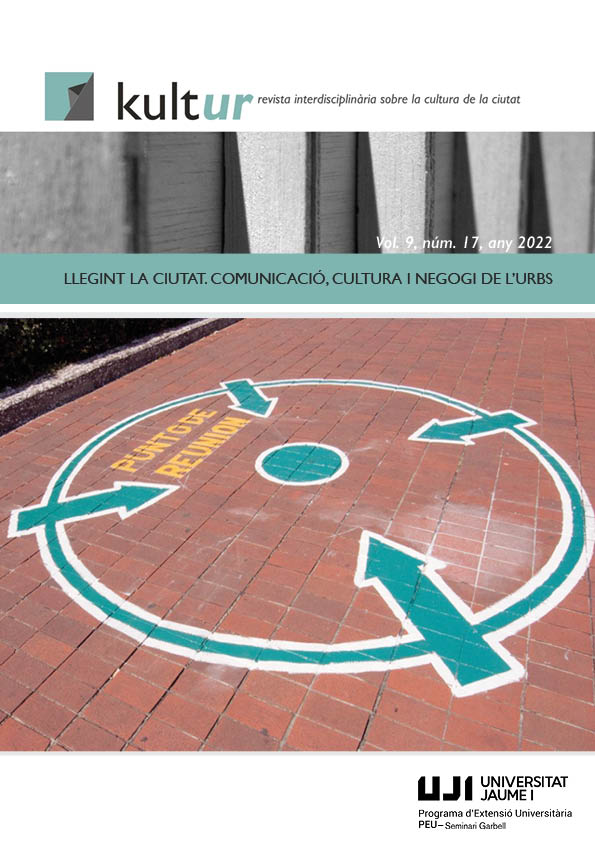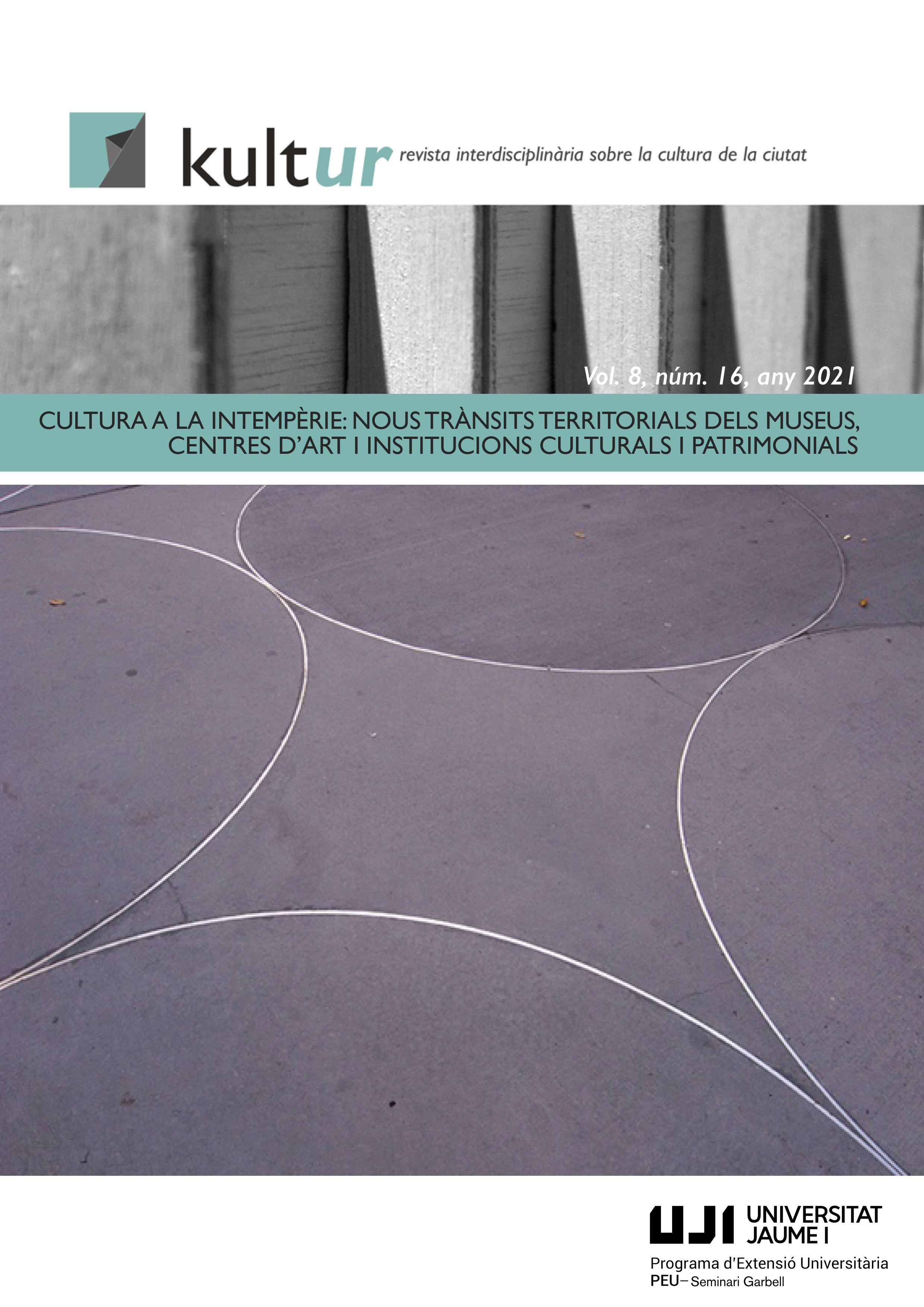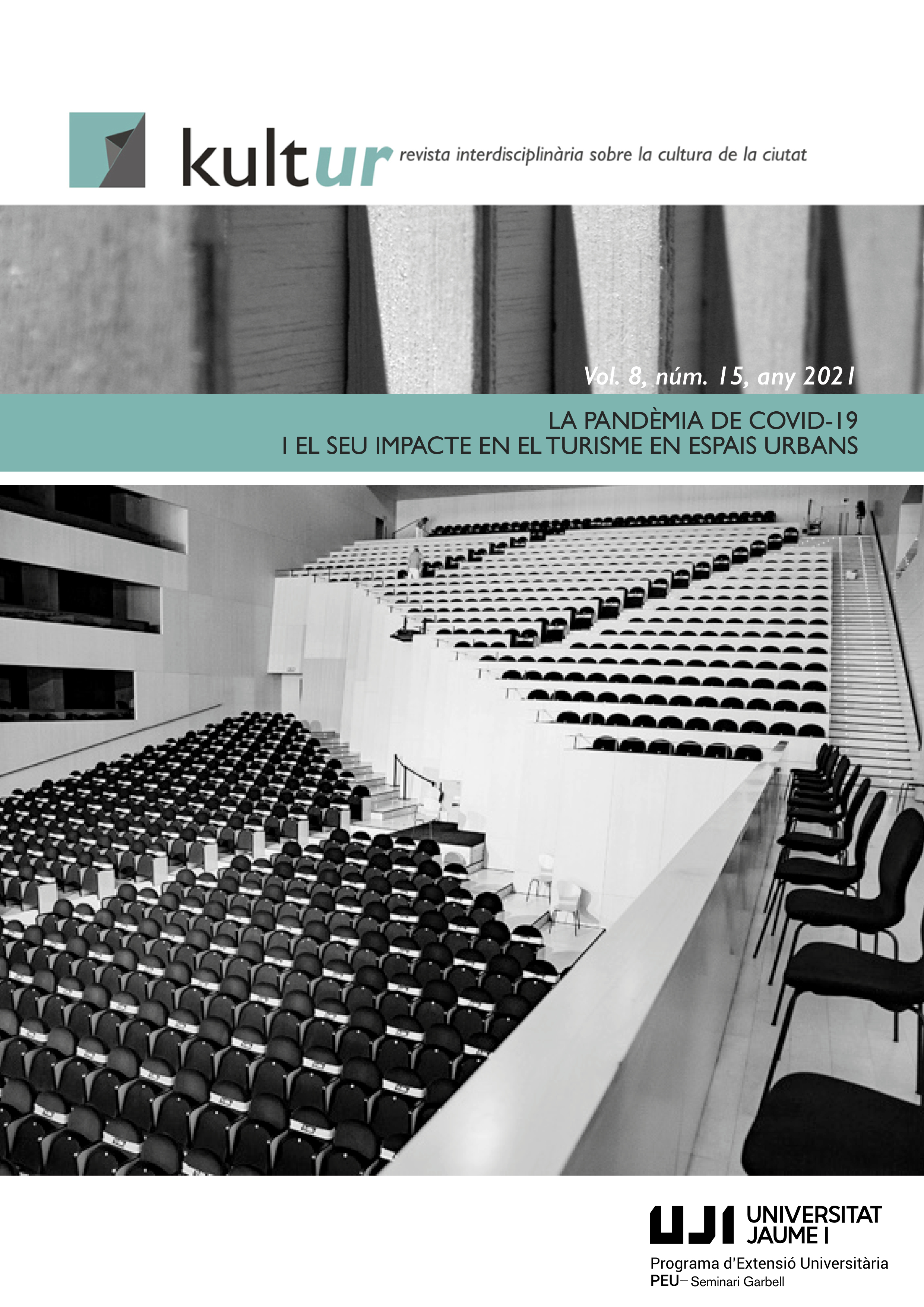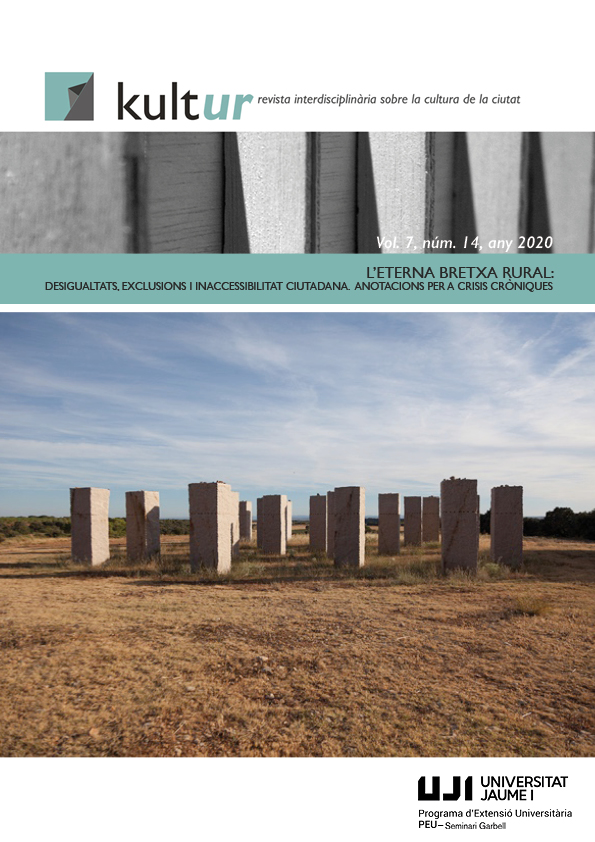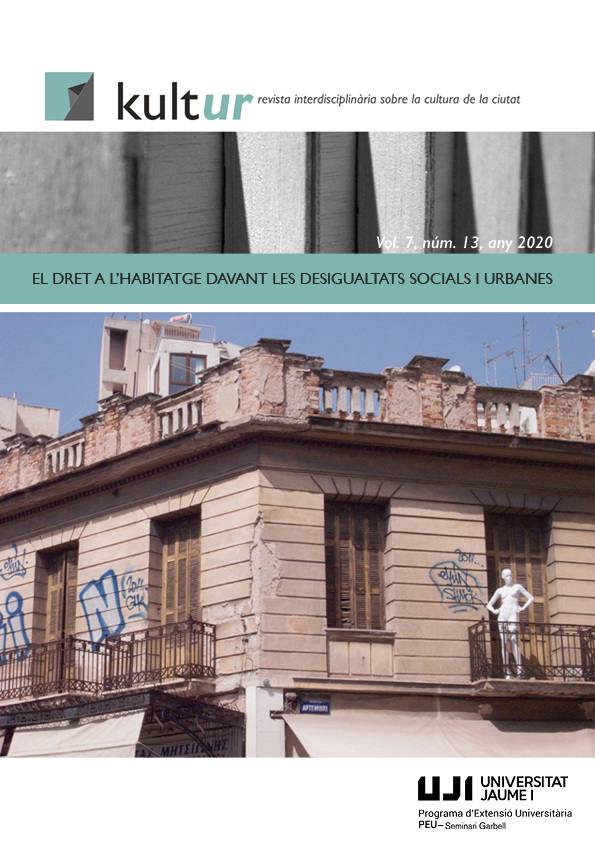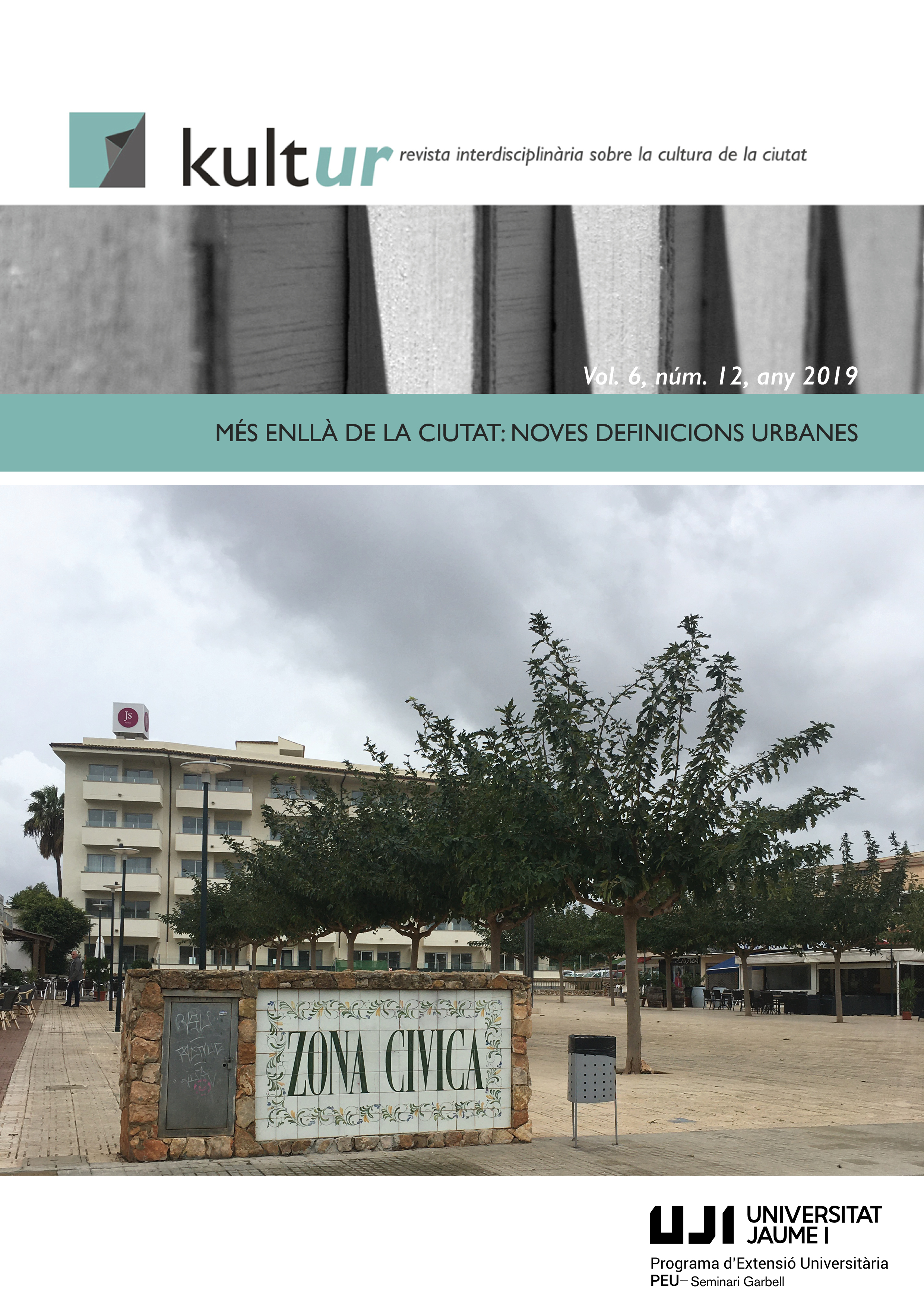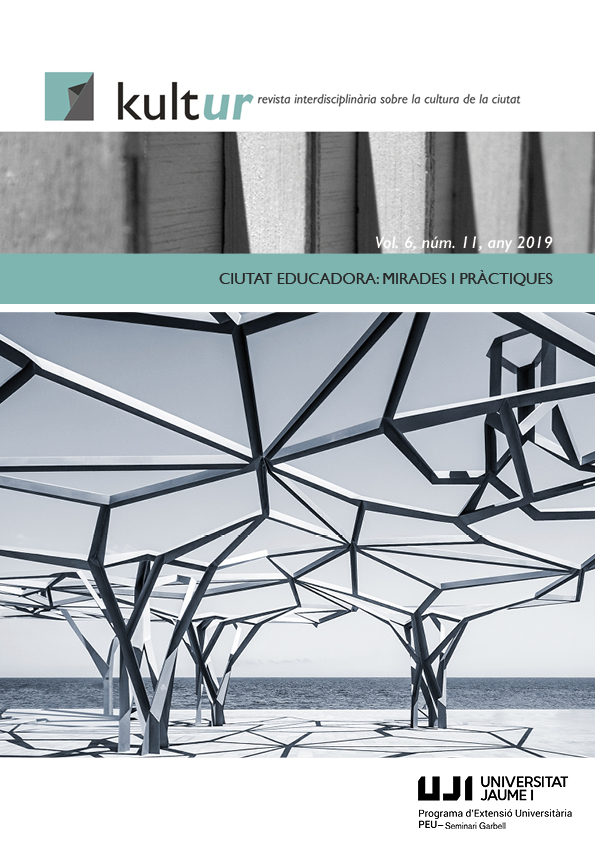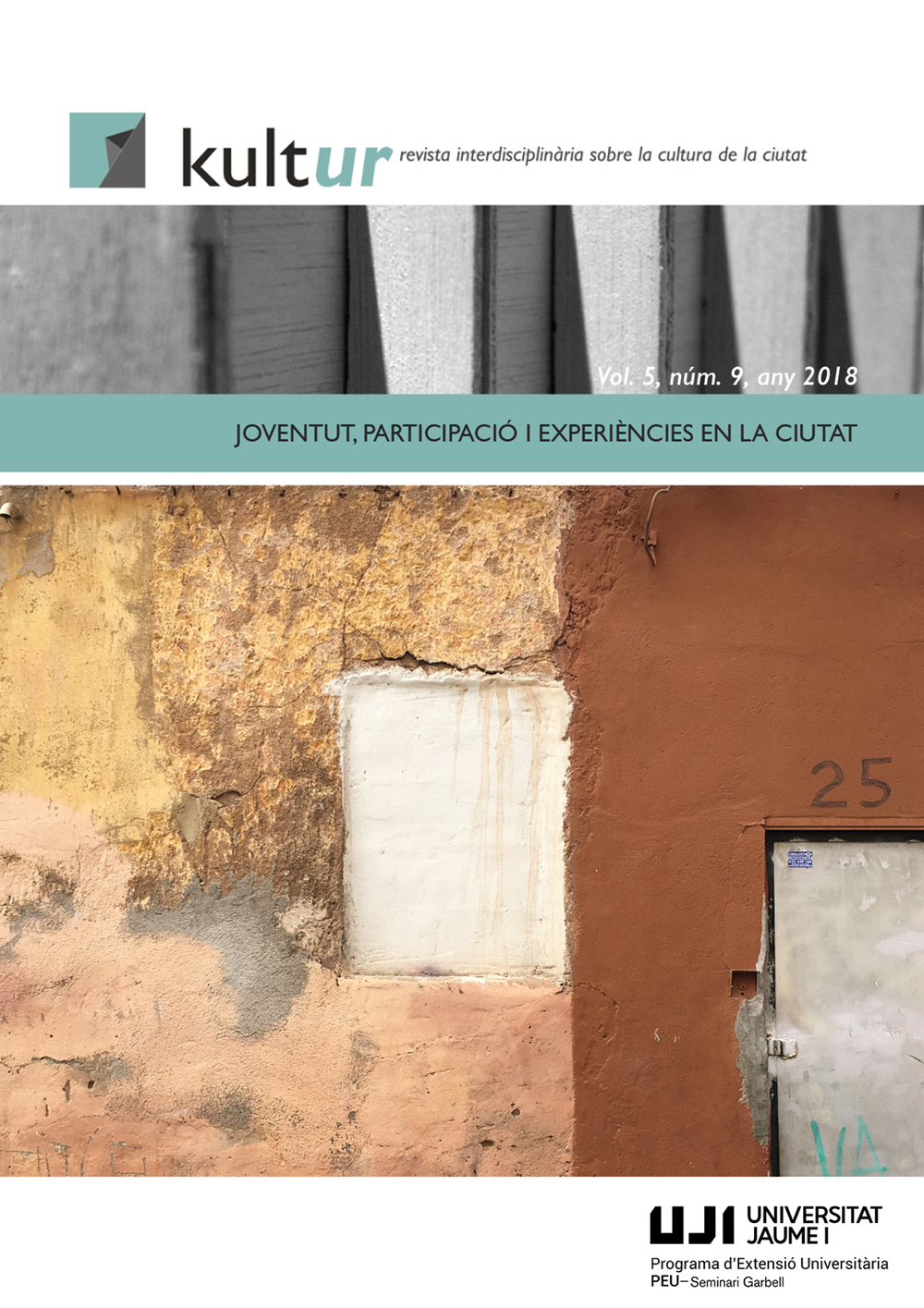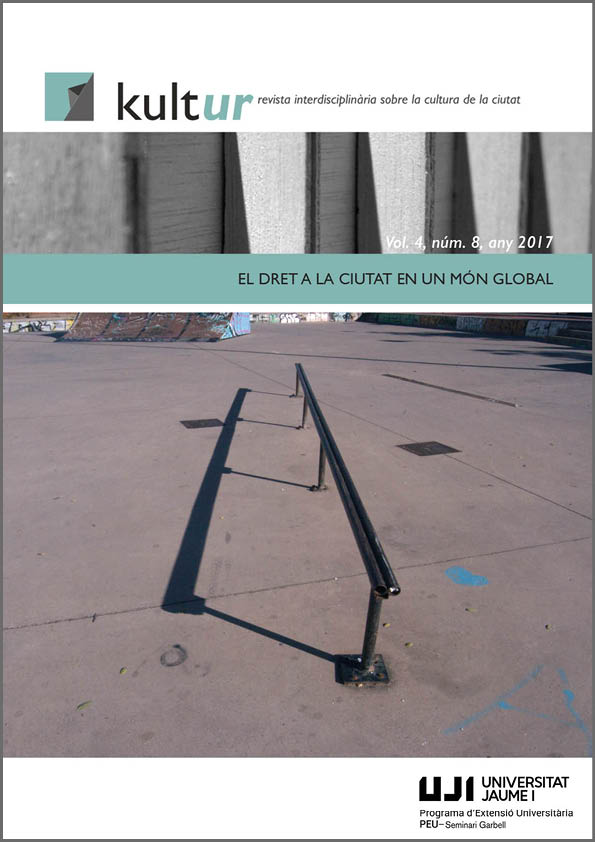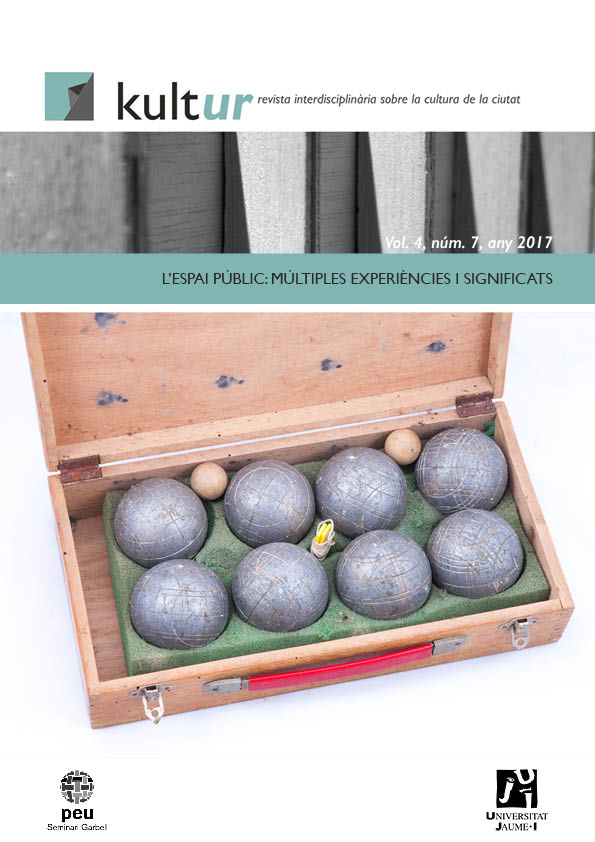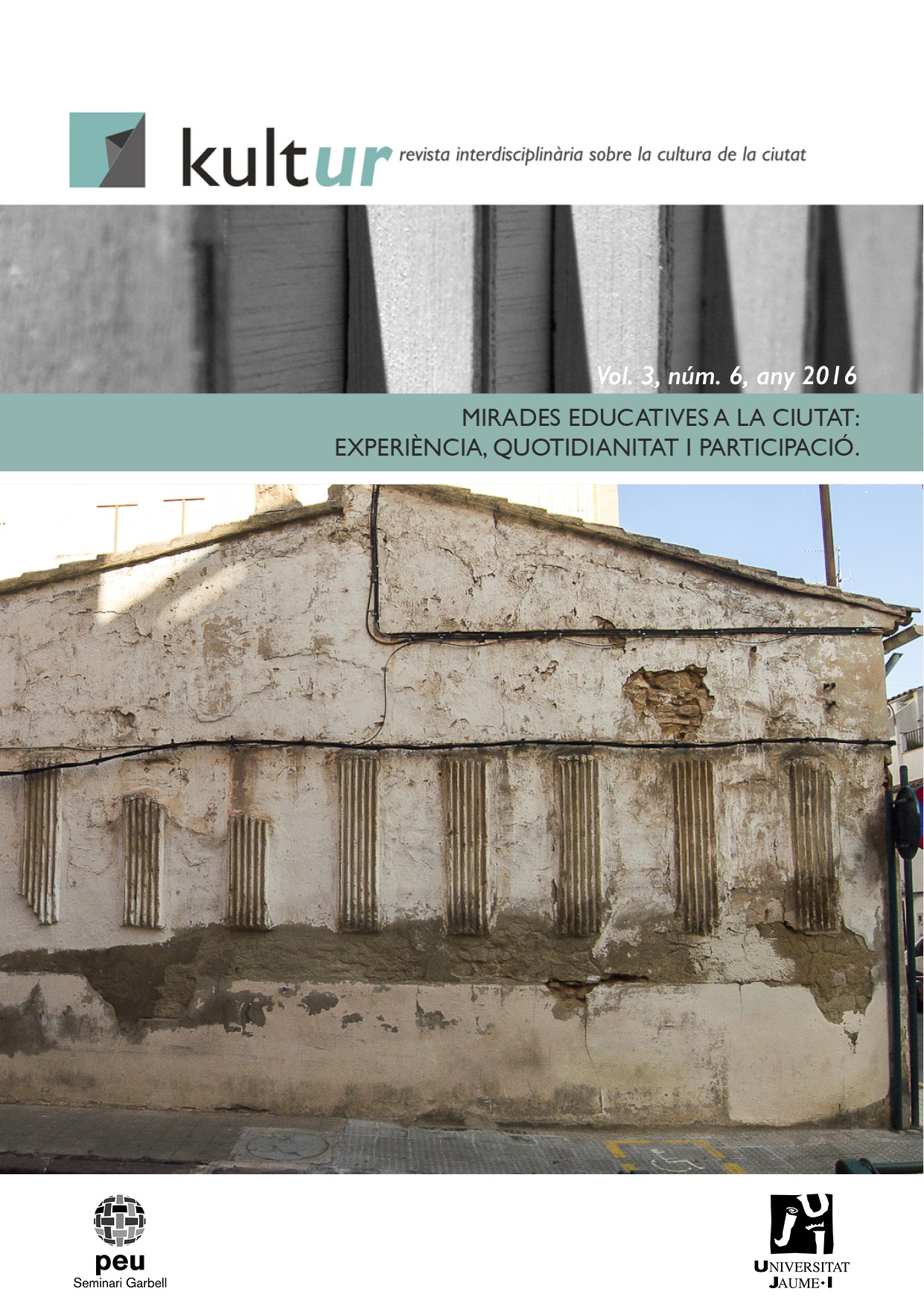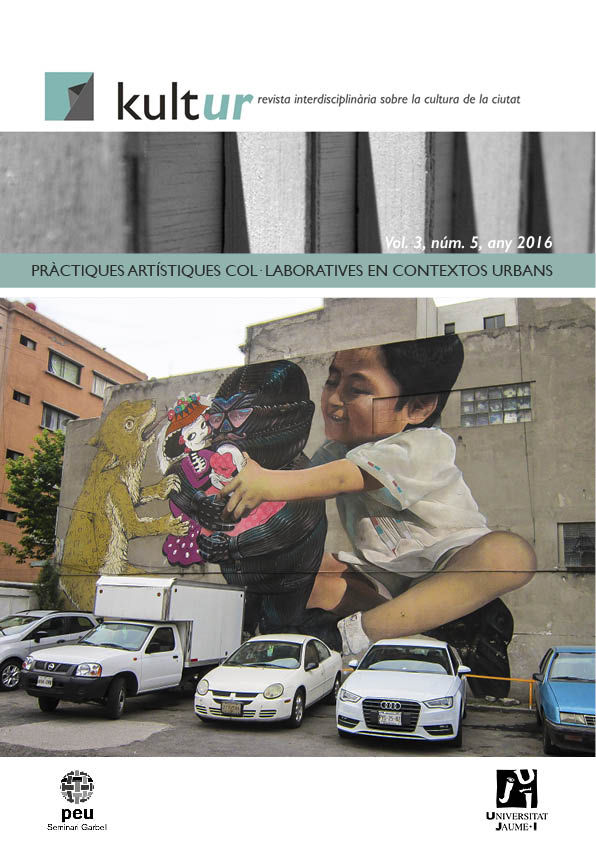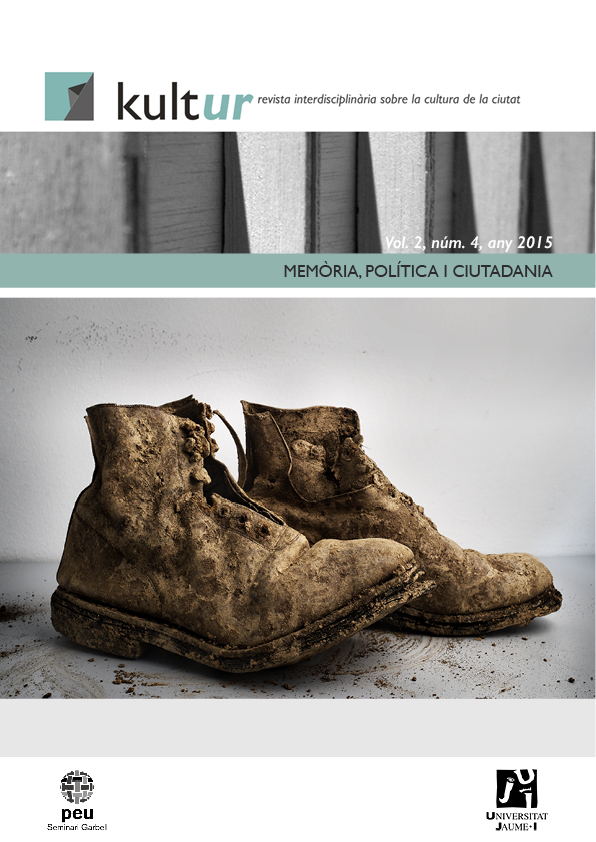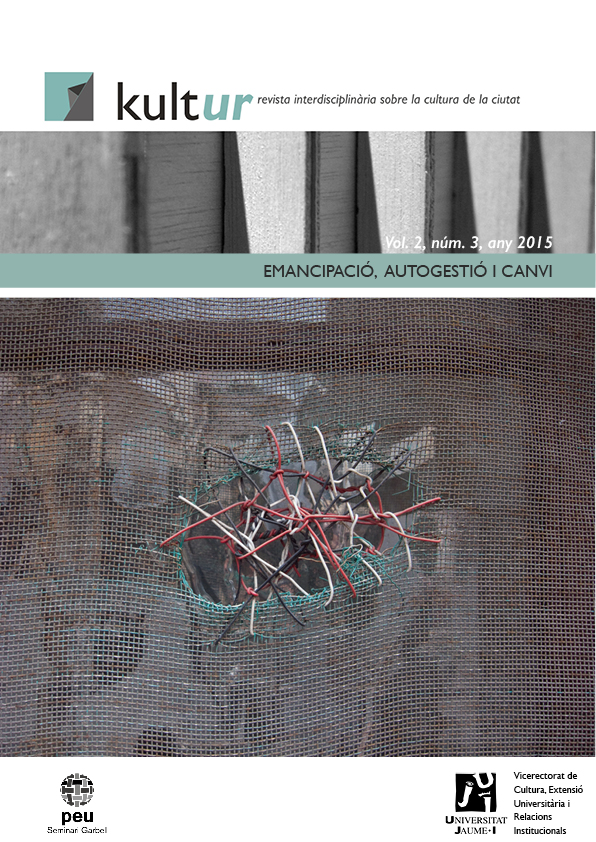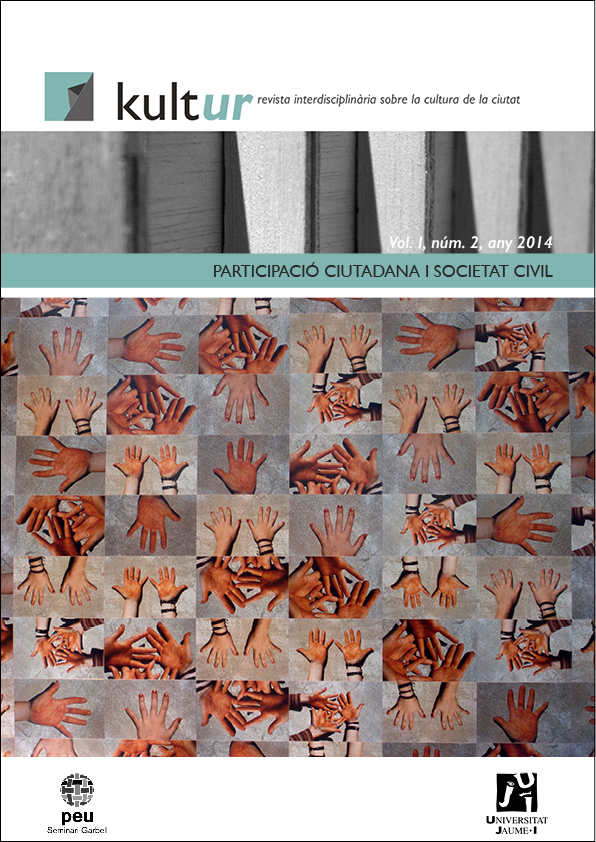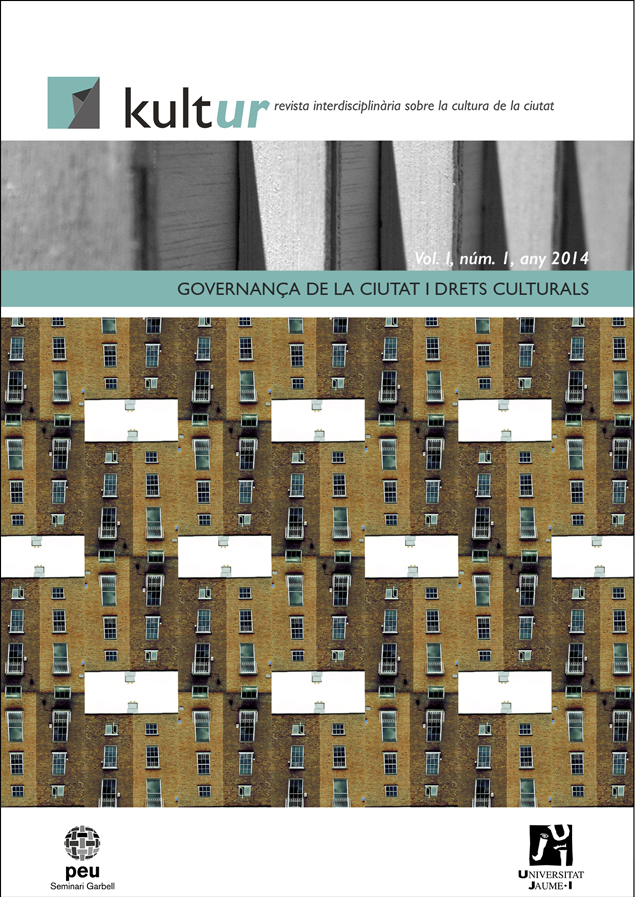Fluxos i Territoris: Formes de vida en l'economia digital.
Vol. 11 No. 22 (2024)
Introduction to flows and territories: Ways of life in the digital economy
Landa (Pedro) Hernández Martínez
Higher Technical School of Architecture of Madrid, Technical University
of Madrid, Spain (doctoral candidate).
pedro.hernandez.martinez@alumnos.upm.es
landahernandezmartinez@gmail.com
The internet, conceived as a decentralised communication network, has grown and evolved into a vast global infrastructure: a web of undersea cables, antennas, satellites, fibre optics, users, mobile phones, data centres and mobile devices that interconnect the world across borders (Bratton, 2015) and seamlessly link up an immense amount of information flows. This infrastructure has enabled significant advances, from telecommunications to consumption, laying the foundations for our current economic model: platform capitalism. Inherent to platform capitalism is the dominance and hegemony of digital platforms, which act as intermediaries between users, consumers, suppliers, advertisers and even physical objects (Srnicek, 2018).
Digitalisation and the form of organising and exchange that platforms promote, by shaping economic processes, have introduced dynamics that directly alter the way we live. In other words, the development of the internet has had a profound impact on the physical, working and social environment.
The simple act of making an online purchase with just one click triggers a complex chain of interconnected processes: an algorithm processes and analyses multiple data in real time to optimise prices, routes and delivery times while humans and robots attend to the strict demands of uninterrupted, non-stop work (Crary, 2017). This entire digital consumer ecosystem is, in turn, underpinned by a sprawling logistics network that ranges from giant data centres to last-mile delivery drivers, often working in highly precarious conditions, who bring any product imaginable to our doorsteps.
In the meantime, cities are being transformed. New spaces spring up every day, such as delivery centres, ghost kitchens, dark stores or lockers. These ‘new’ architectures reshape the use and perception of urban space, displace traditional activities and generate new demands and needs for resources or mobility. Furthermore, internet-driven digitalisation has not only reconfigured the use of territory; it also affects the relationship between people and the objects that surround them. Each day we connect to dozens of technological interfaces (apps) that monetise every interaction and mediate many of our daily transport, shopping or work decisions.
In parallel, although this model has brought innovations that facilitate access to services of all kinds, from remote working to streaming entertainment, it has also increased inequalities. Bodies and territories become cogs in a wheel designed to maximise the continuous flow of goods and services in a form of exploitation that depends as much on mass personal data collection and intensive surveillance of our digital footprints (Zuboff, 2019) as on the extraction of resources such as rare earth minerals. Platform capitalism operates under an extractivist rationality that prioritises acceleration, operational efficiency, planned obsolescence, labour casualisation, and consumption at any cost. This translates into the manifest sacrifice of quality of life, job stability and the sustainability of the urban environment. Time, emotions and even private spaces, such as residential accommodation used for temporary rentals, have become economic assets and marketable goods.
The expansion of the internet and digitalisation raises urgent questions about how to regulate a system for which there is often no legislation. This technological efficiency, which prioritises profitability over well-being, must be balanced with equity, guaranteeing labour rights and protecting privacy and the use of public space. Reflection on this economic model could focus on how to redesign its dynamics to give greater weight to the common and collective, as well as to sustainability, without sacrificing the advantages of digitalisation. The construction of a more just future will depend on our ability to transform current logics and reclaim personal autonomy and social agency in a world increasingly mediated by platforms dominated, in the vast majority of cases, by private corporations.
Against this background, the Agora section of this issue of kult-ur invites us to think about the impact of these transformations and to understand, first of all, what they entail so we can then begin to imagine other possibilities for living and relating to each other, to technology and to the environment that go beyond exploitation or profitability.
Pau Olmo begins by introducing us to the physicality of the cloud, which, rather than an immaterial concept, is built on concrete physical places: data centres, huge spaces for storing data that consume enormous energy and water resources. Far from abstract concepts, these installations are specific urbanisms and respond to logics of economic and geopolitical power. Having explained this, Olmo then proposes alternative models, such as distributing data centres in communities, thus enabling the democratisation of their use and opening the debate to new models of data and energy governance so we can collectively imagine more equitable and sustainable futures.
In their article, Diego Morera and Rodrigo Delso explore how algorithms reconfigure urban time and space through the rationales of efficiency and acceleration mentioned above. Digital food delivery platforms act as urban infrastructures that use data and machine learning to optimise processes, from food selection and preparation to delivery. This creates tensions with traditional human and urban temporalities, transforming public space and social relations. Virtual restaurants and ghost kitchens illustrate how this algorithmic logic prioritises closely monitored time over human interactions, reducing public spaces to mere logistics hubs.
Azahara Cerezo, in turn, encourages us to rethink our relationships with technology, particularly with technological devices, which she understands as “blind objects”.
Unlike “black boxes”, which allude to the invisibility of internal processes, blind objects are broader structures that include environmental impacts, colonial dynamics and social inequalities. She approaches this concept, and the blindness that structures the manufacture and distribution of certain devices used in art exhibitions, such as virtual reality headsets, televisions or loudspeakers, through the art project Rutas raras. El trazado de la tecnología (Strange Routes: The Mapping of Technology), which she developed with Marc Padró (Colectivo Estampa), in an attempt to reveal the systems of global power and dependence present in everyday technologies and to reflect on their ethical, social and political implications.
Finally, Aissa Santiso offers alternatives for thinking about forms of digital relationships which go beyond the use of platforms or systems that depend on large technology companies. To do so, she explores various collaborative dynamics that have emerged from Latin American NFT communities, highlighting how blockchain technology has facilitated new forms of cooperation and governance. Resources such as royalties, splits, multi-signature wallets and DAOs have been key to implementing horizontal and transparent models for managing digital assets, offering other innovative forms of governance, decentralising decisions, promoting more inclusive practices and suggesting alternative models of economic and social interaction.
These articles are complemented by reviews of two books in the Biblo section: Atlas of AI. Power, politics and the planetary costs of artificial intelligence, by Kate Crawford, and Una rápida compañera. Arquitectura y trabajo en la Cuarta Era de la Máquina, by Víctor Muñoz Sanz, which expand on the topics addressed in this volume and analyse the material and social impact on living beings and the places we inhabit of, respectively, artificial intelligence and automation.
In this issue of kult-ur, we want to reflect on the profound impact of platform capitalism and digitalisation on our everyday lives, territory and social dynamics. In this approach, we explore the physicality of the cloud, the ethical challenges of everyday technologies, urban reconfiguration and decentralised governance alternatives. This issue seeks not only to understand the present, but to imagine a more equitable, sustainable and humane future.
Join us on this journey to imagine our relationships with technology, people and the environments in which we live.
References
Crary, Jonathan. 2015, 24/7. El capitalismo tardío y el fin del sueño. Ariel. Barcelona.
Srnicek, Nick. 2018. Capitalismo de plataformas. Caja Negra Editora. Buenos Aires.
Bratton, Benjamin H. 2015. The Stack. Massachusetts Institute of Technology. Cambridge.
Zuboff, Shoshana. 2019. The Age Of Surveillance Capitalism. Profile. London.
Childhoods in pandemic and post-pandemic
Vol. 11 No. 21 (2024)
Infàncies en pandèmia i postpandèmia
Emma Gómez Nicolau (Universitat Jaume I)
Elisabet Marco Arocas (Universitat de València)
Les restriccions de mobilitat, el tancament d’equipaments educatius i la falta d’una mirada inclusiva de les poblacions en les mesures preses durant la crisi sanitària mundial derivada del COVID-19, van posar en relleu la situació de vulnerabilitat de les infàncies en els diferents contextos i regions, urbanes i rurals. Les condicions socioeconòmiques, culturals, educatives i d’accés a mitjans tecnològics en els diferents territoris van reforçar les bretxes de desigualtat. Per a fer front a això, també van emergir estratègies de resistència en els espais més travessats per la vulnerabilitat. Les infàncies van viure la transformació completa de la vida quotidiana a conseqüència de les mesures de control sanitari que es van implementar per a tota la població. Especialment, la interrupció dels processos educatius i les restriccions en l’accés i ús d’espais públics de joc, esport i oci van suposar una vulneració flagrant dels drets de les infàncies.
Les reflexions acadèmiques sobre l’impacte de la COVID-19 no es van fer esperar i, durant aquests anys, hem pogut llegir revisions i anàlisis crítiques que, des de diverses disciplines, han tractat d’abordar i donar llum a la forma en què l’episodi de la pandèmia va canviar, almenys de manera temporal, els modes de vida, les rutines, els espais i els temps, i les experiències de les infàncies i adolescències. Des de la sociologia de la infància i altres propostes teoricometodològiques de diverses disciplines que s’inscriuen en els anomenats «estudis de la infància», s’ha analitzat i reflexionat la forma en què les societats han donat respostes a les necessitats dels xiquets i les xiquetes en la pandèmia, sense ignorar el protagonisme de les infàncies i les adolescències per a afrontar les circumstàncies viscudes i posant el focus d’atenció en les seues pròpies experiències.
En el mateix 2020, la revista Sociedad e Infancias publicava el volum 4, «Las infancias en el foco de la investigación y vivencias infantiles de la pandemia», que arreplegava les primeres troballes i reflexions d’estudiosos i estudioses de la infància fonamentades en l’atenta escolta de les veus de xiquets, xiquetes i adolescents en les circumstàncies que estaven vivint. També des de l’àmbit de la sociologia de la infància, Iván Rodríguez (2020) analitzava l’escenari pandèmic i donava compte de com es convertia en caldo de cultiu per a noves formes de pràctiques i discursos adultistes que normalitzen i legitimen formes de discriminació de la població infantil. La investigació científica es va encarregar de donar compte dels impactes de la pandèmia en la salut i el benestar de les infàncies (Valero et al., 2020) especialment en les interseccions amb la diversitat (Lillo-Navarro et al., 2023) o la identitat (Platero i López, 2020). El qüestionament sobre la vulneració dels drets de les infàncies (Corona-Caraveo i Pérez, 2023; Espinosa, 2020) no va fer més que posar en el focus l’adultocentrisme de les polítiques públiques i l’escàs paper que, des de les administracions, se’ls dotava a les infàncies com a subjectes i ciutadania. No obstant això, la investigació realitzada des dels estudis de la infància ha destacat les capacitats de resistència de les infàncies i la seua capacitat creativa d’adaptar els espais a les seues necessitats (Freire-Pérez, 2021) que posen de manifest la necessitat d’incorporar-les de manera participada en el disseny dels espais públics. També les anàlisis van certificar la capacitat d’aprenentatge en models educatius i d’atenció descentralitzats marcats per la no-presencialitat que remarca la necessitat d’abordatges interdependents amb enfocaments comunitaris (Maestripieri i Gallego, 2022) en la pràctica educativa. Perquè, en definitiva, durant la pandèmia vam poder veure i experimentar com els modes de vida, treball i criança en el capitalisme tardà són altament incompatibles amb la vida.
En l’àmbit de la producció científica, a vegades sembla que la COVID-19 quede lluny i superada. Per contra, no podem deixar de parlar, investigar i analitzar els seus efectes. Alguns canvis globals provocats per la pandèmia al llarg d’aquests anys han adquirit caràcter estructural i altres podrien consolidar-se en un futur pròxim.
El número monogràfic de kult-ur que presentem naix del desig d’aportar, de manera més assossegada, coneixement sobre la pandèmia i els seus impactes a través d’anàlisis situades sobre processos en els quals l’agència infantil compta. Els treballs que compilen aquest número se situen dins de l’etiqueta «estudis de la infància». Al llarg de les últimes dècades, diverses disciplines han desenvolupat formes per a abordar l’estudi de la infància que han donat lloc a aquest camp d’investigació internacional i interdisciplinari. Com sosté Gaitán (2019) en l’àmbit de les ciències socials, aquesta etiqueta no respon a una disciplina o subdisciplina, sinó més aviat s’aplica a una certa mena de propostes teoricometodològiques en l’estudi de la infància. Fent ús de la proposta de Martin Woodhead, resumeix tres trets clau que caracteritzen els estudis d’infància contemporanis: el primer es refereix a la infància i explica les diferents formes en les quals la infantesa es construeix socialment, la qual cosa afecta com s’estudia i teoritza; el segon al·ludeix als xiquets i xiquetes, i destaca el reconeixement de la seua condició de subjectes agents i el seu paper en la societat com a base per a la investigació, les polítiques i la pràctica professional; i el tercer es refereix a la relació entre la infància i l’adultesa, assumint que no es pot estudiar ni comprendre la infància sense atendre les relacions intergeneracionals, és a dir, com es construeix en relació amb altres grups (Gaitán, 2022).
«Àgora», la secció monogràfica, obri amb el treball de Maite Araya Barra, Alexander Salin Espinoza, Nicolás Acuña Contretas i Esperanza Cuadros Danyau titulat «Entre cuidados y resistencias: la escuela popular “El Sueño de Todos” y la construcción de espacios educativos en la zona sur de Santiago de Chile». En aquest article s’arreplega i analitza el procés de construcció comunitària d’un espai d’educació popular en un assentament informal construït durant la pandèmia de la COVID-19 i marcat per les lògiques d’exclusió urbanes. El centre de l’anàlisi radica en com les dinàmiques participatives comunitàries generen pràctiques d’atenció basades en la interdependència. El cas d’estudi que es presenta implica la presa de decisions comunitàries i participades al llarg del procés: des de la construcció física de l’escola fins al disseny dels continguts pedagògics i les activitats a desenvolupar. L’educació popular es concep com un espai d’atenció que promou el protagonisme de la comunitat i la seua capacitat de provisió d’atencions col·lectives. L’escoleta «El Sueño de Todos» constitueix una experiència de resistència i empoderament comunitari que emergeix des de les necessitats que imprimeix la pandèmia en termes de falta d’accés als recursos educatius formals. Malgrat les limitacions, construir una escola popular representa un projecte de futur en el qual es materialitza el somni col·lectiu de millors condicions de vida per a xiquets, xiquetes i joves. En aquest sentit, l’escola popular es posiciona entre l’atenció i la resistència, i ens convida a pensar en la responsabilitat com una lluita política des de la perspectiva comunitària.
Iván Rodríguez Pascual, Sara Luna Rivas Luna Rivas , Teresa González-Gómez i Mari Corominas Pérez plantegen en el seu treball «Una apocalipsis grande y de la buena: hacia un uso sociológico de la narración infantil en la investigación sobre los efectos de la pandemia» un procés d’investigació sobre narratives infantils a través de la tècnica de l’storytelling . El treball de camp per a generar les narratives infantils el constitueixen set tallers realitzats en diferents llocs de l’Estat espanyol amb xiquetes i xiquets d’entre 7 i 14 anys, amb un total de 56 participants. El procés d’investigació és un exemple de com la investigació sobre i amb les infàncies requereix metodologies i tècniques creades i adaptades per a la investigació d’aquestes. En l’anàlisi de les narratives s’identifica tant el sentit emocional de les històries generades pels xiquets i les xiquetes com l’agència infantil present en aquestes narratives. D’aquesta manera, els i les autores analitzen l’impacte de la pandèmia sobre la vida infantil i la seua representació des d’una perspectiva fenomenològica interpretativa.
Norma Baca Tavira i Sandra García Gutiérrez, en el seu estudi «Pandemia y postpandemia. Escuela y vida cotidiana de niñeces rurales en el centro de México», també s’endinsen en la tasca d’analitzar la vivència de la pandèmia per part d’infanteses en la ruralitat mexicana a través de tècniques narratives, en aquest cas, la conversa i la realització de dibuixos després de la lectura d’un conte. La ruralitat es conceptualitza des de la diversitat i la hibridació en una interconnexió amb les dinàmiques socioeconòmiques urbanes. En l’article es discuteixen aspectes relacionats amb les bretxes existents en la ruralitat i, específicament, abunden en la bretxa digital i com aquesta va afectar els processos d’escolarització de xiquets i xiquetes. De les anàlisis portades a terme destaca com les infàncies, en plasmar les diferències entre la vida pandèmica i postpandèmica, mostren a través de la seua subjectivitat l’agència infantil en els processos d’aprenentatge a través del joc en espais en els quals els límits entre la casa i la naturalesa són difusos.
Constança Pérez Ravanal i Carolina Aroca Toloza presenten un treball etnogràfic realitzat en una plaça pública a Santiago de Xile en «Habitar el espacio público: un derecho de las infancias». La pandèmia va evidenciar que l’accés als espais públics i d’oci per a les infàncies va quedar profundament desatès. En aquest context de reflexió sobre les infàncies i el dret a la ciutat, les autores van dur a terme un projecte de disseny d’una proposta lúdica participativa basada en l’agència relacional per a fomentar la recreació i experimentació de la primera infància en espais públics de la ciutat de Santiago de Xile. Des d’un enfocament qualitatiu, s’observen les interaccions entre les infàncies que s’acosten a utilitzar el parc, dotat d’objectes quotidians per a fomentar el joc simbòlic i relacional. Els resultats apunten que els xiquets i les xiquetes resignifiquen l’espai públic com a lloc de trobada i participació i hi posen de manifest la seua agència relacional.
En «Stoa» comptem amb l’anàlisi de Joan A. Traver Martí sobre el projecte educatiu de les escoles infantils municipals a Pamplona centrades en el concepte de presència. «Estar presente y dar presencia. El proyecto educativo de las escuelas infantiles municipales en Pamplona» descriu els elements centrals de la reflexió pedagògica en temps d’acceleració social. Davant d’això, la presència —ser present i donar presència— es concep com a fonamental per a sostindre pràctiques pedagògiques fonamentades en l’atenció i el reconeixement ple de l’altre o l’altra. Evitar l’imperatiu, atendre els moments com si foren escenes, viure un temps alentit i implicar la comunitat sota la lògica de la interdependència, són alguns dels aspectes més suggeridors per a repensar les pràctiques d’educació infantil sobre les quals es reflexiona en el text.
Per a tancar, de la mà de Lucas Sáez González, ens endinsem en la història del Teatro La Estrella dedicat quasi mig segle a la infància. «Teatro La Estrella, 45 años de historia» descriu l’exposició realitzada des de març a juny de 2024 en Centre del Carme Cultura Contemporània (CCCC) de la ciutat de València, que recorre la història de la família Fariza-Miralles i, amb ella, l’origen del Teatro La Estrella, una companyia valenciana referent en el món dels titelles. A partir de la biografia de Gabriel Fariza i Maite Miralles, els pallassos Bombalino i Cuchufleta, fundadors de la companyia i de la seua família, ens conta el naixement de la sala de teatre La Estrella coneguda com la Sala Cabanyal, construïda en 1995 i encara hui activa. Una sala que es va enfrontar amb les polítiques de renovació urbana impulsades pel govern municipal i autonòmic que pretenien l’ampliació d’una avinguda fins a la mar i que amenaçaven el barri del Cabanyal, i que suposava la destrucció de vivendes i, amb això, la seua desaparició. El text refereix la resistència i la lluita veïnal que va evitar la prolongació de l’avinguda, l’enderrocament de més vivendes i la salvació de la sala La Estrella. Actualment, la companyia disposa d’una altra sala, La Petxina, que va nàixer de la incertesa i el desconcert davant les polítiques de renovació urbana. Dues sales que encarnen en les seues propostes i en les seues pròpies dinàmiques una aposta política per la infància i el seu protagonisme. Dues sales que es van enfrontar amb la pandèmia COVID-19 i es van reinventar per a poder continuar existint per a i amb la infància.
En suma, els diferents articles que componen aquest volum tracten d’aportar el seu granet d’arena als aprenentatges i també a les innovacions socials que es van posar en marxa durant la pandèmia per a tractar de donar resposta a les noves exclusions i desigualtats generades per la gestió de la pandèmia en les xiquetes i els xiquets, les seues famílies i comunitats. Encara que els repunts per contagi de coronavirus ens serveixen de record del que va succeir durant els confinaments, els modes de vida accelerats, productivistes i extractivistes van tornar a instal·lar-se ràpidament en les «noves normalitats». És per això que reivindiquem mirar enrere i tornar a repensar sobre el que es va innovar i va crear en un moment d’efervescència col·lectiva com aquell en el qual, com expliquen Fattore i col·legues (2023), en les narratives infantils, a més de por compartida, també hi havia solidaritat, empatia i altruisme.
Referències
Corona-Caraveo, Yolanda, y Pérez y Zavala, Carlos. 2023. “Infancias invisibles: la vulnerabilidad de niñas, niños y adolescentes ante la pandemia de Covid-19”. TRAMAS. Subjetividad y Procesos Sociales, 33, no. 57: 323–350. Recuperado a partir de https://tramas.xoc.uam.mx/index.php/tramas/article/view/979
Espinosa, M. Ángeles. 2020. “Covid-19, Educación y Derechos de la Infancia en España”. Revista Internacional De Educación Para La Justicia Social 9, no. 3: 245–258. https://doi.org/10.15366/riejs2020.9.3.013
Fattore, Tobia, Drake, Gabrielle, Falloon, Jan. et al. Disruption, Slowness, and Collective Effervescence: Children’s Perspectives on COVID-19 Lockdowns. International Journal on Child Maltreatment 6, 393–413 (2023). https://doi.org/10.1007/s42448-022-00147-4
Freire-Pérez, Estella. 2021. “Infancia y Confinamiento. Prácticas Espaciales de Resistencia”. Arte, Individuo y Sociedad 33, no. 2: 553-570. https://doi.org/10.5209/aris.69024
Gaitán Muñoz Lourdes. 2022. “Debates y desafíos en la sociología de la infancia ante una nueva era”. Política y Sociedad 59, no. 3: e79783. https://doi.org/10.5209/poso.79783
Gaitán Muñoz, Lourdes. 2019. “Los estudios de infancia en España. Una introducción”. En Gálvez Muñoz, Lina y Del Moral Espín, Lucia (dirs): Infancia y Bienestar, una apuesta política por las capacidades y los cuidados. Sevilla. Deculturas.
Lillo-Navarro Carmen, Robles-García Verónica, Quintela del Río Alejandro, Macías-Merlo Lourdes, Konings Marco, Monbaliu Elegast. 2023. “Impacto del periodo de confinamiento por la pandemia COVID-19 en España sobre la salud y la atención recibida por los niños, niñas y jóvenes con discapacidad originada en la infancia”. Fisioterapia 45, no. 2: 74-83.
Maestripieri, Lara y Gallego, Raquel 2022. El impacto de la pandemia COVID-19 en la sociedad en el sur de Europa: el caso de la innovación social en el cuidado de la primera infancia en Barcelona. Revista Española De Sociología 31, no. 4: a131. https://doi.org/10.22325/fes/res.2022.131
Platero Méndez, R. Lucas y López Sáez, Miguel Ángel. 2020. “Perder la propia identidad”. La adolescencia LGTBQA+ frente a la pandemia por COVID-19 y las medidas del estado de alarma en España. Sociedad e Infancias 4: 195-1
Rodríguez-Pascual, Iván. 2020. “¿De invisibilidad a estigmatización? Sociología del adultismo en tiempos de pandemia”. Linhas Críticas 26: e36364. https://doi.org/10.26512/lc.v26.2020.36364
Sociedad e Infancias. 2020. “Presentación. Llegó la pandemia y mandó parar….” Sociedad e Infancias 4: 1-3. https://doi.org/10.5209/soci.70365
Valero Alzaga, Erika, Martín Roncero, Unai y Domínguez-Rodríguez Antía. Grupo Confisalud. 2020. “Covid-19 y salud infantil: el confinamiento y su impacto según profesionales de la infancia”. Revista Española de Salud Pública 94: e202007064
Vegeu comentari en el document de l’editorial.
Alerta, sembla que está repetit
Vida quotidiana, experiències i conflictivitats soci territorials en espais de costes i riberes
Vol. 10 No. 20 (2023)
Las costas y riberas en tanto territorios adyacentes a grandes masas de agua, se conforman como espacios intersticiales donde se entretejen dinámicas sociales que articulan la vida cotidiana entre el agua y la tierra. Confluyen allí dinámicas vinculadas a procesos y transformaciones que permiten repensar las dicotomías como lo rural urbano. A su vez, las problemáticas en torno al acceso al agua y a la tierra forman parte de luchas históricas que ponen de manifiesto situaciones de desigualdad estructural en las que algunas poblaciones se encuentran.
Distintos antecedentes de investigación dan cuenta en las últimas décadas, como estas relaciones de poder se han complejizado. En este sentido, se puede identificar cómo se han ido generando marcas y orientaciones que a la hora de analizar o investigar poblaciones que habitan las costas y riberas son necesarias de ser tenidas en cuenta. El cambio climático, la crisis energética, el avance inmobiliario sobre costas y/o riberas, las concesiones público-privadas, los procesos de turistización de las ciudades y/o áreas rurales, ponen de manifiesto situaciones tensionales que viven en su vida cotidiana las poblaciones que habitan estos territorios.
Se trata de territorios en los que habitan sujetos sociales que producen, reproducen y resignifican en su vida cotidiana estos espacios. En consecuencia, recuperar las formas en que estos espacios sociales son vividos; las experiencias formativas intergeneracionales que suceden en acto en estos territorios; los vínculos que se tejen entre el estudio y el trabajo, así como también en las distintas actividades productivas que allí se realizan. Recuperar los conocimientos y prácticas que estos actores de las costas y riberas tienen, se vuelve indispensable para comprender de manera pro-funda cómo esas vidas sociales se entrelazan en y con estos espacios intersticiales de tierra y agua. Es así que se espera que puedan presentarse estudios que den cuenta de la complejidad de la vida social y cómo ésta es atravesada por transformaciones de orden estructural.
L’urbanisme agroecològic
Vol. 10 No. 19 (2023)
Des de fa aproximadament seixanta anys, la provisió d’aliments a les ciutats, la manera en què la ciutadania adquireix els aliments o la forma en què es produeixen han canviat a poc a poc fins a prendre una forma que pràcticament no té cap similitud amb la tradicional. La industrialització i, amb aquesta, el model econòmic denominat capitalista, han provocat un canvi socioeconòmic radical que no ha deixat cap espai ni concepte sense transformar.
L’urbanisme desmesurat de les ciutats en constant creixement ha engolit el sòl agrícola que les circumdava i que en suposava la font d’aliments. La producció agrícola i ramadera s’ha industrialitzat del tot. El món rural continua buidant-se sense fi. Això ha comportat, en conseqüència, un gran nombre d’efectes secundaris no desitjats, d’externalitats que tenen resultats negatius que són insostenibles per a les persones, la societat, el territori i el planeta: pèrdua de biodiversitat, contaminació mediambiental, crisi climàtica, malalties cròniques relacionades amb l’alimentació, acaparament corporatiu del sistema productiu, aliments ultraprocessats, obesitat, etc. La població ha esdevingut consumidora d’aliments, la indústria busca beneficis econòmics amplis sense limitar l’ús de recursos, i l’Administració afavoreix lleis i acords que ens aboquen a models extractius insostenibles i insalubres.
En aquest número de la revista kult-ur us convidem a la reflexió i a l’anàlisi de la situació actual de la ciutat i la relació d’aquesta amb el món rural, amb la finalitat de trobar un sistema alimentari que facilite la preservació de la biodiversitat i la producció d’aliments d’una manera sostenible, no contaminant; en el qual la població que produeix aliments i la que els consumeix s’organitzen des de la justícia, l’equitat, el dret i la sobirania. En definitiva, busquem propostes i idees que corregisquen les diverses disfuncions, insostenibles, que han sorgit en el desenvolupament industrial del sistema alimentari.
Universitat i ciutadania activa: expandir la institució
Vol. 9 No. 18 (2022)
Llegint la ciutat. Comunicació, cultura i negoci de l'urbs
Vol. 9 No. 17 (2022)
The city is a repository of social networks and a web of interests that compete and cooperate and, by doing so, constantly redefine the frameworks, the identities and even the names of the city. Cities create themselves in the tension between the rules of good governance and the demands of people’s lives. City governance, land use and the design of spaces all determine the quality of the resulting ecosystem, the visibility of people, groups and social classes. The symbolic management of the city, the administration of its heritage and the arrangement of its cultural infrastructures open up or close down the field for cultural activism among its inhabitants, for the circulation and contagion of culture, and for the inclusion or segregation of diversity. How urban powers communicate determines how citizens communicate with each other and the distribution of the assets and value generated in the city. Finally, how people are managed and the city’s social policies determine the dynamics of the inevitable social tension, the development of protest movements or citizens’ resistance to the designs of economic power, a power which aspires to free itself from the city and its inhabitants.
In all these ways, the city is a network of communications, a hubbub of discourses debating what is to be done with the city and what the city decides to be, without asking anyone.
If we only read the regulations, the executive orders and plans, if we fail to interpret the subtext of what people do, the amendment to the city development plan that people trample on, the way local communities use and abuse the regulations, pro domo sua, we will not understand the city, where it came from or where it is headed.
Coord. Pepe Reig-Cruañes (jose.reig@uclm.es, Universidad de Castilla La Mancha) i Fran Sanz-Sánchez (OCOVAL, Oficina de Coordinación de las Obras de Valencia, Ayuntamiento de Valencia, sanzfra@gmail.com)
The COVID-19 pandemic and its impact on tourism in urban spaces
Vol. 8 No. 15 (2021)
As well as its serious health effects, the COVID-19 pandemic is also wreaking social and economic havoc, and the current crisis is forecast to be especially punishing. One of the most badly affected activities is tourism, unlike the situation following the 2008 global financial crisis in which the sector played a crucial role in economic recovery and job creation. The almost total suspension of all tourist activity over a period of several weeks, and its slow, uncertain recovery––also dependent on how the pandemic evolves in other parts of the world––augur serious difficulties for economies that rely heavily on tourism. This situation has highlighted the vulnerability of regions, and particularly urban spaces, that have undergone an intense touristification process in recent years.
This context of crisis, with its grave implications for the lives of many people, has opened up an intense intellectual debate on how we should intervene in such a situation, a debate polarised between those calling for urgent public funding to reactivate the tourism economy, others arguing for a reappraisal of its current operational model, and yet other voices demanding more drastic deceleration measures and processes of socio-ecological transition. Not all contexts are the same in this debate, and more detailed, complex analyses are called for. At the same time, faced with the paralysis of international tourism and its unsettled, precarious reactivation, interest has grown in domestic tourism and particularly in different forms of local tourism, which in contrast to its traditionally more modest role in public policies, could go some way to reviving the sector.
The eternal rural divide: inequalities, exclusions and citizen inaccessibility. Notes for chronic crises.
Vol. 7 No. 14 (2020)
The urban–rural relationship is historically one of inequality. Despite the endeavours of rural development and the improving quality of life in small towns and villages, the rural divide remains and is patently visible from the perspective of citizenship. Depopulation is nothing but a symp- tom of the lack of territorial cohesion and civic inequality. Small differences can sometimes generate great distances.
This debate has become especially apparent in the 21th century, dur- ing which the spate of crises—the great recession of 2009 and the health emergency of the 2019 global pandemic—relentlessly affect our societies and as such, leave their mark as a defining factor in today’s rurality and the now endemic nature of the urban–rural divide.
The right to housing in the face of social and urban inequalities
Vol. 7 No. 13 (2020)
Beyond a simple buildings forthat accommodates one or more people to live in, dwellingshousing is are complex and multifaceted propertiesy that embodyincludes a variety of means and purposes. Housing can be a source ofprovides pride;, it provides a foundation for the family, a cultural and collective identity, a network, social support, and security for the people who live there. It is also thea basis onby which the members of a human group of people are rooted in a territory and a community, but whichand also allowoffersing them also to protect themselvesprotection from the territory community and the communityterritory. IncreasinglyHowever, several phenomena are increasingly weaken undermining this relationship with housing and spaces.
Just some examples of these phenomena areT the forced relocation of the tenants to allow the developers to transform the built environment, increasing housing sanitation problems of sanitation of the dwellings that contribute to social exclusion, continuous escalating increase in rents in the absence of adequate regulation mechanisms, and discrimination that limits access to housing for certain categories of individualssocial groups are just some examples. ThePeople who suffer victims of these phenomena, including tenants, face eviction processes that force them out of dispossession of their living spaces and neighborhoods. The inequalities embedded in these phenomena have multiple dimensions that can interact with each other, whether they beregardless of being political, spatial, economic or even environmental, and have impacts at the individual, family, social and territorial levels. The refore, the study of inequalities in housing istherefore offers a relevant sociological entry point to understand what characterizes contemporary social experiences, especially in the urban contextones, but also the social question of, that is, how unequal social relations are implemented.
Renaud Goyer & Jean-Vincent Bergeron-Gaudin, coord. Àgora
Beyond the City: New Urban Definitions
Vol. 6 No. 12 (2019)
One fundamental definition that has influenced much of our nowadays world organization is that of “city”. Certain definitions of “city”, tightly linked to land use and property, exist on the basis of the modern organization of societies, economies and the politics of the world. With that also emerged a “cultural divide” between cities and countryside, including a development divide that often supports the maintenance of asymetrical development paths and socio-ecological interactions. Formal, informal, ruled, desired, imagined conceptions of “city” contribute to this process. As the global human population steadily becomes more urbanized; as cities become central to regulate socio-ecological interactions; as the limits, functions and definitions of cities become more blurred it is timely to renovate the understanding of what is “city”.
Andrea Yuri Flores Urushima & Benoit Jacquet, coord. Àgora
The Educating City: Views and Praxis
Vol. 6 No. 11 (2019)
At a time when cities face unprecedented challenges, where urban life is increasingly diverse and complex, the paradigm of the educating city presents a conceptual framework, inspired by the 20 principles of the Charter of Educating Cities, whith tools for local governments to build forms of coexistence, encounter and sustainability.
Of course, to achieve this goal, although based on common principles, different strategies and actions are used in relation to different socio-political contexts.
Therefore, in this issue of kult-ur, we have participations from Japan, Brazil, Spain, Mexico and Portugal.
We have sought collaborations that equate the current relevance of the concept, reconciling them with the prac- tical experiences of the actions that consolidate the concept of the Educating City.
Paulo Louro, coord. Àgora
Rural social spaces as objects for reflection, intervention and dispute.
Vol. 5 No. 10 (2018)
The present monograph proposes d'examiner les reconfigurations matérielles, politiques, sociaux, culturelles et symboliques des espaces ruraux actuels dans le cadre des tendances à l'homogénéisation du capital et des politiques néolibérales.
Notre intention a été de faire appel à des chercheurs de différentes disciplines à partir disquelles sont discussed, réfiées et essentialisées les visions qui dichotomisent la vie sociale des champs et montrent, au contraire, the multiple social relations qui unissent la campagne et la ville.
Nous revenons à cette question, the question that l'anthropologue argentin Hugo Ratier and notre teachor María Rosa Neufeld ont pose à l'anthropologue argentina lorsqu'elles nous ont sued quels domaines et villes ne sont pas clairement délimités, opposés et exclus, et nous ont demande de de l'urbain est présent dans la vie rurale et vice versa. «Combien de ruralités connaissez-vous?». Ils ont insisted: "Le rural doit être I explained." Ils nous ont appelé à avertir cela modifiait les réalités historiques, à la fois en elles-mêmes et dans leurs interrelations. Ces déclarations peuvent sembler evidentes, mais nous rassemblons cet appel pour explicate toujours socialement et historiquement la manière dont les vies rural sont configurées de manière complexe et ne pas considérer ce nous trouvons là comme de simples obstacles ou de anticipations de l'avenir.
The travaux rassemblés ici permettent précisément de discuter avec des visions anhistoriques et essentialisantes et de montrer the complexity of processus qui ont peu à voir avec des verses qui multiplient encore. Nous nous référons d'une part à ceux accusés d'un certain fatalisme démographique, social et culturel, supposing the disparition of villages ruraux dans le cadre d'un inévitable développement évolutionniste, sans s'interroger sur le pourquoi et ignorant les mouvements existants , formes de production matérielle et sociale. symboliques qui sont redéfinis, les résistances, les réappropriations et reconfiguration identitaire des rural. The works that no présentons discutent également avec les visions romantiques et optimistes qui proposent le retour au champ, à la nature, à une vie bénigne et réparatrice, qui invisibilise les relations de pouvoir et l'exploitation des ouvriers ruraux (avec ou sans terre) , Ils semblent is fondre dans le paysage.
Elisa Cragnolino, coord. Àgora
Youth, participation and experiences in the city
Vol. 5 No. 9 (2018)
The four articles published in the Ágora section of this edition respond to the call for research articles (paraphrasing the original CfP) exploring how young people experience and act in the urban spaces they live in, how they recreate them and construct contemporary cities. Emphasis was also placed on studies applying participatory methodologies and new forms of documenting and carrying out research with/about young people and adolescents in the city. We considered that a call for submissions within these parameters would also provide a platform for research using visual, multimodal and sensorial methodologies and/or digital resources, as well as qualitative and/or ethnographic studies. More broadly, the call aimed to share research that places the experiences and voices of adolescents and young people in urban contexts at the centre of analysis.
Finally, despite the current pressure on the academic community to channel their work towards high-impact journals, often with restricted access and in the hands of multinational publishing conglomerates, we hoped to bring together articles that would reflect the diversity of social, economic, cultural and institutional conditioning factors, with particular attention to the geographical and disciplinary diversity that may be represented in the set of proposals.
David Poveda y Ligia Ferro, coord. Àgora
Vol. 4. iss.8 (2017). The right to the city in a global world
Vol. 4 No. 8 (2017)
The right to the city is based on processes of participation and social inclusion as drivers of change, on access to the city as a collective right. Drawing on these postulates, kult-ur proposed on this occasion to seek out visions and attitudes that contribute to this collective construction of the right to the city for everyone, without exception.
Natalia García Fernández, coord. Àgora
Public space: multiple experiences and meanings
Vol. 4 No. 7 (2017)
Public space as a political space of social representation; publicly owned space with unrestricted use, access and enjoyment; space synonymous with free space; space as the city’s structure and the foundations for everyday life; space for memory and literary construction... The construction of a public space, whether physical-spatial, social, cultural, literary or political, is rooted in the peculiarities and singularities of each culture and geography. And even in this ever globalised world, public space, although apparently uniform, has its peculiarities and singularities.
Zaida Muxí, coord. Àgora
Educational views in the city: experience, everydayness and participation
Vol. 3 No. 6 (2016)
The city is a cultural complex that brings together the knowledge and experiences represented in its streets and squares, but also its dynamics, traditions and narratives. Taking an educational look at the city involves rethinking the imaginaries around which we construct ourselves as subjects, and with which we articulate our lives in society. In this line, aspects like experience, everydayness or participation frame the analysis of the educational processes that occur in the city.
An analysis of the relationship between education and city leads to a generic formulation that embraces many other specific aspects such as neighbourhood and school, streets and citizens, celebrations and participation, discourse and transformation, among others, all of which derive from the concrete realities and problems that are experienced and acted upon. These responses also revolve around a pedagogical discourse in which we can identify their dynamics, projects and ways of relating. Contributions to the monographic should explore this educational view on the processes of collective subjectivation and construction that develop in our cities.
Mar Estrela Cerveró, Coord. Ágora
Collaborative artistic practices in urban contexts
Vol. 3 No. 5 (2016)
The city has provided contemporary art with a frame and focus for constant experimentation. Since the beginning of the twentieth century, various art movements have experimented with the links between art and life, trends that have grown exponentially since the sixties. These practices have questioned and extended the boundaries of traditional arts, combining with other disciplines and integrating into daily life to become a forceful field of socio-cultural and political experimentation. Experiences with varied forms of participation and collaboration have been key in these artistic practices to questioning and transforming socio-cultural contexts. The upsurge in these collective practices has been accompanied by a growing interest in reflecting on collaborative and participatory methodologies and processes. All these processes have played a part in questioning essential aspects of the art system, such as the value of authorship, the viewer’s role, modes of production and management or the conception of the idea of representation, among others. These issues, which may be reflected in other spheres, have been approached from the arts in perhaps a freer and more experimental way than other contexts allow. By experimenting with participatory practices, between the recreational and full engagement, art has anticipated and made visible, as a laboratory, conflicts, debates and social transformations that have deep undercurrents for the present. In the current neoliberal, post-Fordist and globalising context, this potential critique from the collaborative and participatory arts is beginning to suffer from a process of domestication and deactivation, which could be symptomatic of other environments. Some of the factors that have contributed to this situation include the conflictive dialogue between the instituting and the institution, which constantly tries to appropriate emerging practices, and the very inertia that comes from the widespread visibility of certain practices, turning anything that becomes popular into a superficial trend. In light of all these factors, this article proposes the need to rethink — reflectively and critically, and from different artistic angles — the meaning and value that participation and collaboration currently have in the urban context.
Teresa Marín, Coord. Àgora
Memory, politics and citizenship
Vol. 2 No. 4 (2015)
kult-ur, a journal dedicated to reflection on the ‘culture of the city’, explores the relationship between memory, politics and citizenship in this edition, considering that memory-related politics take place within the coexistence in the city. In other words, the politics of memory are originally located in the coexistence among fellow citizens, in contrast to the imperial exercise of political dominion. Memory occurs in this fundamental siting of citizens that is the city; hence, Hannah Arendt calls the polis “a kind of organized memory” (2003: 220). Because memory is fleeting and short lived, it needs consolidated institutional spaces in order to last beyond the act of its realisation, and within this stable space the political actors who keep the memory alive can be seen and heard in public. But remembering also implies approaching the past from “the instant of danger” (Benjamin, 2008: 307), revealing its dark sides and resisting those who want to impose the notion that the dead are just that: dead (Reyes Mate, 2009: 115).
The articles contained in this issue seek to initiate new discussions and debates about the relationship between memory, politics and citizenship. Specifically, they explore the tensions that arise between the processes of institutionalisation and the polemics in constructing memory in Argentina and Spain. […]
Guillermo Pereyra, Cood. Àgora
Emancipation, Self-management and Change
Vol. 2 No. 3 (2015)
In the Agora section of Issue 3 of kult-ur (vol.2) entitled Emancipation, Self-management and Change there are a number of articles that converge around the need to regain sovereignty from different perspectives. This third monograph, invites a critical rethinking of the importance of concepts such as Empowerment, Public Space, Self-Management and Participation, interalia; it proposes that such consideration is not only feasible but trans-formative, in that such rethinking argues the need to return to the starting point, and actively participate in the construction of the spaces in which we live.
Aniol Pros, Coord. Àgora
In addition to the regular sections Extramurs (academic papers on papers on topics different than the ones included in the monographic section ), and Biblos (book reviews), we are featuring a new section, Stoa, of interviews and reports related to various topics in the magazine.
Citizen participation and civil society
Vol. 1 No. 2 (2014)
We follow up the topics dealt with in our previous issue by focusing on the recovery of autonomous movements of citizens concerned about the brutal downturn in the general living conditions of the population and the dismantling of social protection structures in our societies.
Esther Vivas, Coord. Àgora
City government and cultural rights
Vol. 1 No. 1 (2014)
In times like the present when politics is widely discredited as a result of the disqualification of the main political actors and the way they have exercised power—paving the way for the emergence of fascist politics—reflection is needed to reconstruct the bases for the way we deal with what is public. There is an urgent need for a kind of politics that differs radically from the fraudulent surrender to economic interests. The forms that city governance might adopt in the present circumstances have motivated kult-ur’s appearance on the scene.
Jordi Pascual, Coord. Àgora


